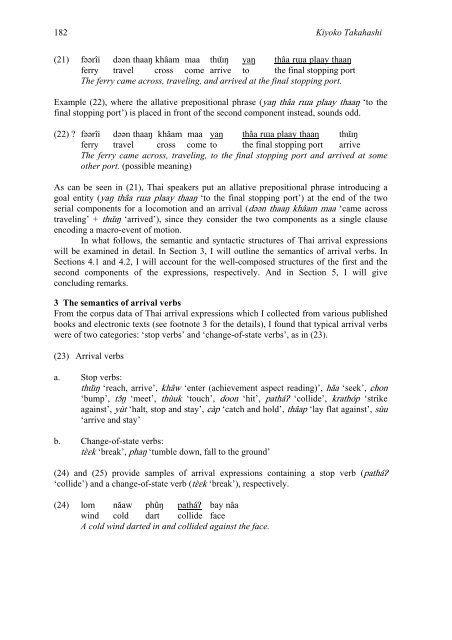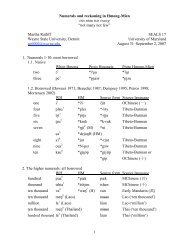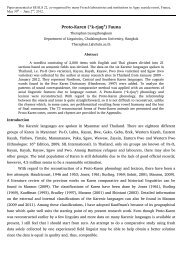proto-southwestern-tai revised: a new reconstruction - seals 22
proto-southwestern-tai revised: a new reconstruction - seals 22
proto-southwestern-tai revised: a new reconstruction - seals 22
Create successful ePaper yourself
Turn your PDF publications into a flip-book with our unique Google optimized e-Paper software.
182 Kiyoko Takahashi<br />
(21) fəərîi dəən thaaŋ khâam maa thɯ̌ ŋ yaŋ thâa rɯa plaay thaaŋ<br />
ferry travel cross come arrive to the final stopping port<br />
The ferry came across, traveling, and arrived at the final stopping port.<br />
Example (<strong>22</strong>), where the allative prepositional phrase (yaŋ thâa rɯa plaay thaaŋ ‘to the<br />
final stopping port’) is placed in front of the second component instead, sounds odd.<br />
(<strong>22</strong>) ? fəərîi dəən thaaŋ khâam maa yaŋ thâa rɯa plaay thaaŋ thɯ̌ ŋ<br />
ferry travel cross come to the final stopping port arrive<br />
The ferry came across, traveling, to the final stopping port and arrived at some<br />
other port. (possible meaning)<br />
As can be seen in (21), Thai speakers put an allative prepositional phrase introducing a<br />
goal entity (yaŋ thâa rɯa plaay thaaŋ ‘to the final stopping port’) at the end of the two<br />
serial components for a locomotion and an arrival (dəən thaaŋ khâam maa ‘came across<br />
traveling’ + thɯ̌ ŋ ‘arrived’), since they consider the two components as a single clause<br />
encoding a macro-event of motion.<br />
In what follows, the semantic and syntactic structures of Thai arrival expressions<br />
will be examined in de<strong>tai</strong>l. In Section 3, I will outline the semantics of arrival verbs. In<br />
Sections 4.1 and 4.2, I will account for the well-composed structures of the first and the<br />
second components of the expressions, respectively. And in Section 5, I will give<br />
concluding remarks.<br />
3 The semantics of arrival verbs<br />
From the corpus data of Thai arrival expressions which I collected from various published<br />
books and electronic texts (see footnote 3 for the de<strong>tai</strong>ls), I found that typical arrival verbs<br />
were of two categories: ‘stop verbs’ and ‘change-of-state verbs’, as in (23).<br />
(23) Arrival verbs<br />
a. Stop verbs:<br />
thɯ̌ ŋ ‘reach, arrive’, khâw ‘enter (achievement aspect reading)’, hǎa ‘seek’, chon<br />
‘bump’, tɔ̂ŋ ‘meet’, thùuk ‘touch’, doon ‘hit’, patháɁ ‘collide’, krathóp ‘strike<br />
against’, yùt ‘halt, stop and stay’, càp ‘catch and hold’, thâap ‘lay flat against’, sùu<br />
‘arrive and stay’<br />
b. Change-of-state verbs:<br />
tɛ̀ɛk ‘break’, phaŋ ‘tumble down, fall to the ground’<br />
(24) and (25) provide samples of arrival expressions con<strong>tai</strong>ning a stop verb (patháɁ<br />
‘collide’) and a change-of-state verb (tɛ̀ɛk ‘break’), respectively.<br />
(24) lom nǎaw phûŋ patháɁ bay nâa<br />
wind cold dart collide face<br />
A cold wind darted in and collided against the face.





